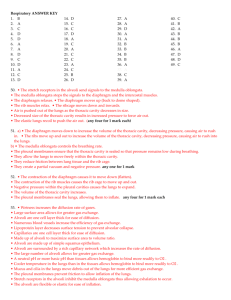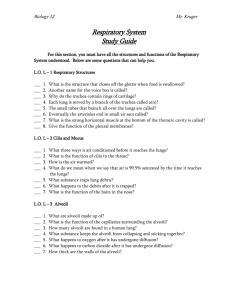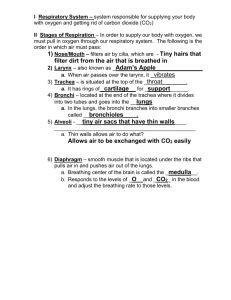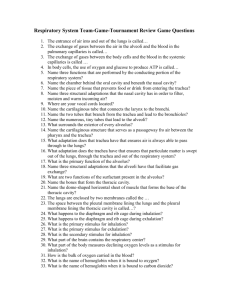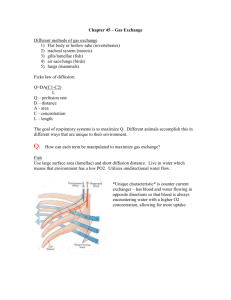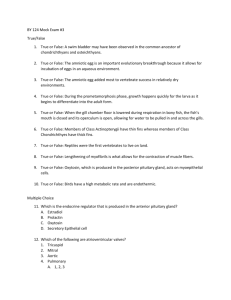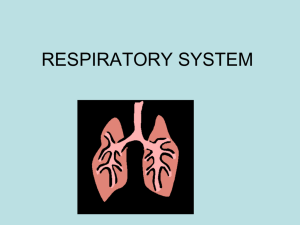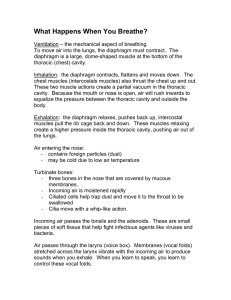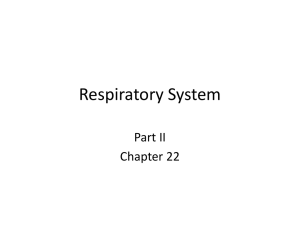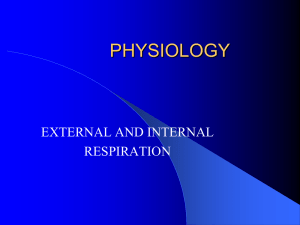The Respiratory System : Review #2 - Mr. Lesiuk
advertisement
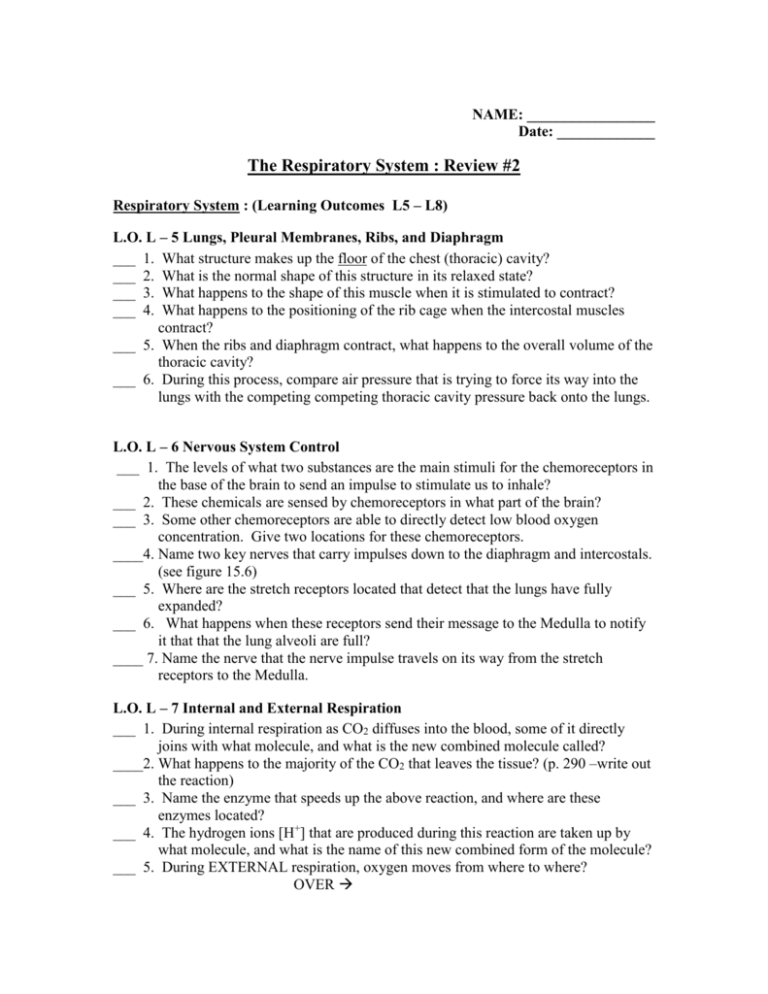
NAME: _________________ Date: _____________ The Respiratory System : Review #2 Respiratory System : (Learning Outcomes L5 – L8) L.O. L – 5 Lungs, Pleural Membranes, Ribs, and Diaphragm ___ 1. What structure makes up the floor of the chest (thoracic) cavity? ___ 2. What is the normal shape of this structure in its relaxed state? ___ 3. What happens to the shape of this muscle when it is stimulated to contract? ___ 4. What happens to the positioning of the rib cage when the intercostal muscles contract? ___ 5. When the ribs and diaphragm contract, what happens to the overall volume of the thoracic cavity? ___ 6. During this process, compare air pressure that is trying to force its way into the lungs with the competing competing thoracic cavity pressure back onto the lungs. L.O. L – 6 Nervous System Control ___ 1. The levels of what two substances are the main stimuli for the chemoreceptors in the base of the brain to send an impulse to stimulate us to inhale? ___ 2. These chemicals are sensed by chemoreceptors in what part of the brain? ___ 3. Some other chemoreceptors are able to directly detect low blood oxygen concentration. Give two locations for these chemoreceptors. ____4. Name two key nerves that carry impulses down to the diaphragm and intercostals. (see figure 15.6) ___ 5. Where are the stretch receptors located that detect that the lungs have fully expanded? ___ 6. What happens when these receptors send their message to the Medulla to notify it that that the lung alveoli are full? ____ 7. Name the nerve that the nerve impulse travels on its way from the stretch receptors to the Medulla. L.O. L – 7 Internal and External Respiration ___ 1. During internal respiration as CO2 diffuses into the blood, some of it directly joins with what molecule, and what is the new combined molecule called? ____2. What happens to the majority of the CO2 that leaves the tissue? (p. 290 –write out the reaction) ___ 3. Name the enzyme that speeds up the above reaction, and where are these enzymes located? ___ 4. The hydrogen ions [H+] that are produced during this reaction are taken up by what molecule, and what is the name of this new combined form of the molecule? ___ 5. During EXTERNAL respiration, oxygen moves from where to where? OVER ___ 6. What changes to the environmental conditions will cause carbaminohemoglobin (HbCO2) and reduced hemoglobin (HHb) to drop off their CO2 and H+ ions to form back into deoxyhemoglobin (Hb)? ____7. When oxygen binds onto Deoxyhemoglobin, what name is given to this new form Of Hemoglobin (Hb) and give its short-hand version or symbol? ___ 8. Back at the lungs, the Hydrogen Ions are picked up by Bicarbonate ions to undergo a reaction to Produce carbonic acid which will break down into what two molecules? ___ 9. What happens to these molecules in order to get rid of them from the body? ___ 10. Explain why Hemoglobin is considered a BUFFER for your blood. ___ 11. Give the chemical formula for a Bicarbonate Ion. L.O. L – 8 Oxyhemoglobin, Carbaminohemoglobin, and Bicarbonate Ions ___ 1. List three ways that carbon dioxide can be transported by the blood. Give the percentage that is carried in each method? ___ 2. Carbon Dioxide is mainly carried in the form of what Ion? ___ 3. Where is the partial pressure of Oxygen the greatest: in tissues or in the lung alveoli? ___ 4. What happens to the amount of oxygen held by hemoglobin when the partial pressure of oxygen decreases? ___ 5. Where is the partial pressure of oxygen least: in tissues or in lung alveoli? ___ 6. What effect does a slightly lower temperature have on the amount of oxygen carried by hemoglobin? ___ 7. Where in the circulatory system is the temperature lowest? ____8. Where in the circulatory system is the pH highest? ____9. What happens to Oxyemoglobin when the temperature rises, and pH lowers at the internal tissues? PRACTICE QUIZ:
